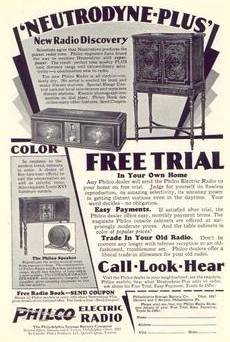|
Philco began in 1892 as a moderately successful manufacturer of carbon arc lamps.
In 1906 the company reorganized into the Philadelphia Storage Battery Company with eighteen employees and
began to turn a profit. In 1919 the familiar Philco trademark was introduced on a new line of batteries know as Diamond Grid
with sales in excessive of four million dollars annually.
| The Philco Diamond Grid Battery |

|
This product line lead the company into the production of an emerging technology called
Radio and by 1930 was hugely successful mainly due to the Baby Grand Model 20 that was relatively affordable. Though 49.50
(less tubes) was a significant amount for the Depression Era the price was affordable to most. This was a strategic
difference between Philco and its competitors who concentrated on the higher priced console market.
By 1931 Philco
was the leading seller of radios and maintained electronics dominance through the Second World War. Philco engineered many
innovations and changed the face of electronics for all time. Today the Philco name, as a subsidiary of the Philips Electronics
conglomerate, can be found on value priced electronics mostly in mass retail.
Philco is an archetypical American success story. It faced adversity many times
but through foresight, innovation, and diligence became ingrained in Americana forever. But the Philcos of the 30s, the romance
and beauty of those fabulous wood cathedrals, are the real attraction for me.
There is great personal satisfaction in rescuing and preserving a part of our
history!

Personal Notes
The history of this hobby surely began in the 1920s with the first curious person
who just had to see what made those tubes glow. The depth of the hobby is quite surprising. There are numerous WEB resources
for procuring radios, parts, technical specifications, reference materials, and even vintage test equipment. Also, as my RELATED LINKS page presents, a wealth of technical and advisory resources are available to
share and help!
Please allow a quick
philosophical note. I do not REFINISH or REPAIR these old sets. I attempt to RESTORE them. I seldom do anything that cannot
be undone. RESTORATION involves preserving the appearance of the old electrical components by hiding new components inside
the old shell, use of authentic lacquer finishes when cabinet restoration is necessary, use of ACTUAL components, grille cloth,
knobs, etc. when replacement is needed. In brief, the objective is to return a set to safe operation while leaving the appearance
close to a well-maintained seventy-year-old artifact.
|

